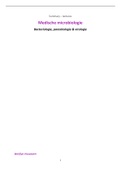Summary
Summary of lectures Microbiology - Biomedical Sciences UvA, year 3
- Course
- Institution
Comprehensive summary (103 p.) of all lectures in preparation for the Microbiology theory exam. Includes all exam material for the three subtopics: bacteriology, virology, and parasitology. Concepts and concepts have been extensively explained and associated figures have also been incorporated (alt...
[Show more]



